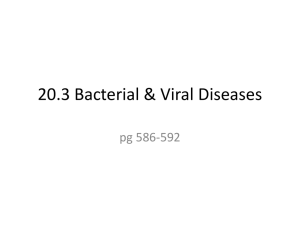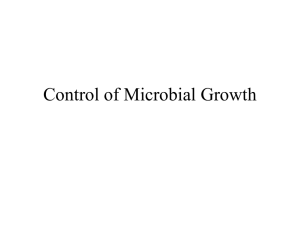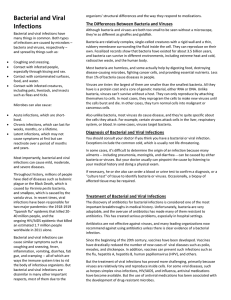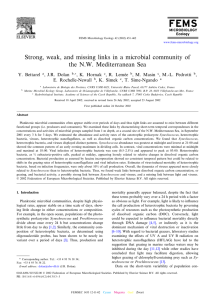20.3 Wkbk Key - OG
advertisement
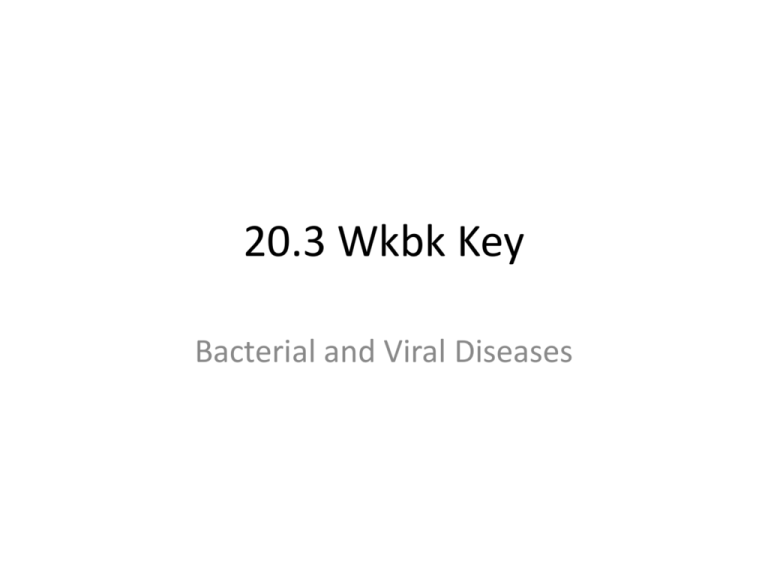
20.3 Wkbk Key Bacterial and Viral Diseases Bacterial Diseases 1. One way bacteria can cause disease is by breaking down and damaging ______________ cells (or tissues) of the infected organism. toxins 2. Bacteria can also cause disease by releasing __________ that harm the body. pathogen 3. A(n) _______________ is a disease-causing agent. 4. One way to control bacterial growth is by subjecting the bacteria to high temperatures during a process known as Sterilization ___________________________. vaccine 5. A(n) _____________ is a preparation of weakened or killed pathogens or inactivated toxins that can prompt the body to produce immunity to a disease. 6. What organs do bacteria that cause tuberculosis typically damage? The lungs 7. What are antibiotics? Compounds that block growth/reproduction of bacteria 8. How are the causes of TB and diphtheria similar? How are they different? Both caused by bacteria. Tuberculosis breaks down tissue, while diphtheria release toxin 9. Describe the similarities and differences of antibiotics and disinfectants. Both kill bacteria. Antibiotics are compounds that kill bacteria in an organisms. Disinfectants are chemical solutions that kill bacteria on surfaces 10. Why should meat be cooked until it is welldone? Cooking meats until they are well done raises the temperature of the meat to a point at which bacteria are killed Match the bacterial control method with an example of the method: D 11. physical removal ___ B 12. disinfectant ___ A 13. safe food storage ___ E 14. safe food ___ processing C 15. sterilization by ___ heat A. Putting milk in fridge B. Using bleach to clean a countertop C. Using boiling water to clean dishes D. Washing hands E. Boiling soup Viral Diseases 16. What are some human diseases caused by viruses? AIDS, influenza, common cold, West Nile, HPV 17. How do antiviral medications work? Why don’t they also kill host cells? They attack specific viral enzymes. Hosts do not have these enzymes 18. A person has a low helper-T cell count. What viral disease does he/she most likely have? A) HPV B) AIDS C)hepatitis B D) chicken pox 19. A person has blister-like lesions on the skin. What viral disease does he/she most likely have? A) HPV B) AIDS C) hepatitis B D) chicken pox Emerging Diseases 20. Pathogens are able to evolve over time. True 21. A(n) noninfectious disease is an unknown disease that appears in a population for the first time. False – emerging 22. The widespread use of vaccines has led to the emergence of resistant strains of bacteria False - antibiotics 23. Slight genetic changes would be needed for a bird flu virus to become infectious to humans. True 24. Scrapie is most likely caused by pathogens known as viroids. False – prions Apply the Big Idea: RNA viruses have shown the ability to evade antiviral drugs. How do you suppose this is possible, when viruses are not alive? How may the reproductive methods of viruses help the process? 25. Viruses reproduce quickly, so their genetic makeup can also change quickly. The DNA of RNA viruses must be translated by the host cell. This allows the opportunity for mutations to occur. Also, many RNA viruses are made inside one cell before bursting forth. They may exchange genetic information at that time. This genetic variation allows them to evolve.








